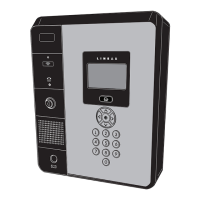14
NO
COM
NC
FAIL SECURE WIRING WITH A DC MAG LOCK
DOOR LOCK RELAY
ENERGIZES WHEN
ACCESS IS GRANTED
POWER SUPPLY
DC POWERED
MAG LOCK
DIODE 1N4002
OR EQUIVALENT
DOOR UNLOCKS
WHEN MAG LOCK
IS DE-ENERGIZED
DC POWER WITH
BATTERY BACKUP
BY STAND-ALONE
SUPPLY OR PDM
WITHOUT CONTROLLER POWER MAG LOCK IS LOCKED
DOOR LOCK RELAY
TERMINALS
NO
COM
NC
FAIL SAFE WIRING WITH A DC MAG LOCK
DOOR LOCK RELAY
DE-ENERGIZES WHEN
ACCESS IS GRANTED
POWER SUPPLY
DC POWERED
MAG LOCK
DIODE 1N4002
OR EQUIVALENT
DOOR UNLOCKS
WHEN MAG LOCK
IS DE-ENERGIZED
DC POWER FROM
STAND-ALONE
SUPPLY OR PDM
WITHOUT CONTROLLER POWER MAG LOCK IS UNLOCKED
DOOR LOCK RELAY
TERMINALS
NO
COM
NC
WIRING TO AN AUTOMATIC GATE OPERATOR
DOOR LOCK RELAY
ENERGIZES WHEN
ACCESS IS GRANTED
GATE
OPERATOR
NOTE: TERMINAL CALLOUTS
ON GATE OPERATORS MAY
VARY - REFER TO THE GATE
OPERATOR'S INSTRUCTIONS
DOOR LOCK RELAY
TERMINALS
OPEN
OPEN
Automatic Gate
The Door Lock Relays can be used to activate an automatic gate operator when a user is granted access.
1. Route two wires between the gate and the unit.
2. Connect the gate operator’s OPEN terminals to the unit’s DOOR LOCK RELAY COM & NO terminals.
NOTE: For operator wiring specics, refer to the gate operator’s wiring diagram. See Recommended Wiring Requirements, pg. 12, for proper
gauge requirements.
Mag Lock
1. Install a low voltage electric magnetic lock as a locking device for the door or pedestrian gate.
2. Install the power supply or transformer for the locking device. DO NOT POWER THE UNIT FROM THIS POWER SUPPLY.
3. Connect one wire from the power supply to one wire from the locking device.
4. Route two wires between the locking device and the unit. Connect one wire to the remaining wire of the locking device. Connect the other wire
to the remaining wire of the power supply.
5. Install a protection diode (for DC mag locks or MOV for AC mag locks) across the mag lock to protect the door relay contacts.
6. Connect the wires to the unit’s DOOR LOCK RELAY COM & NC terminals for fail secure operation or DOOR LOCK RELAY COM & NO
terminals for fail safe operation.
NOTE: For fail secure operation with a magnetic lock, the lock’s power supply must have battery backup to power the lock during a power
failure. Be sure to comply with NFPA and local building code requirements.

